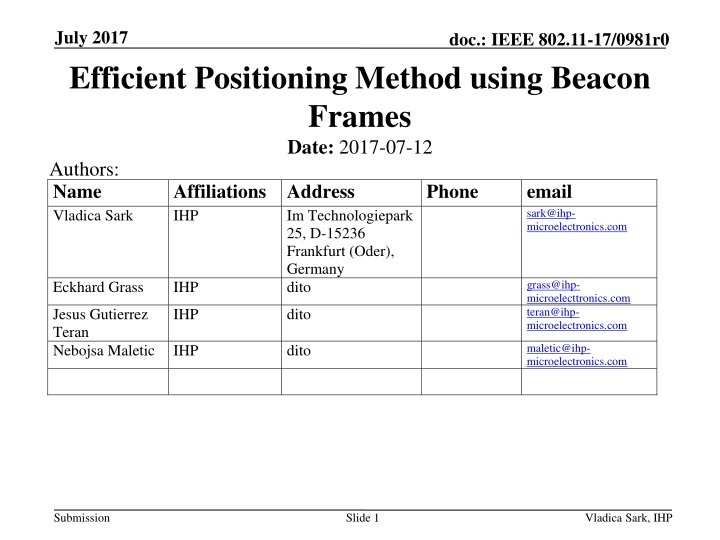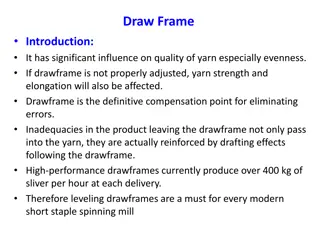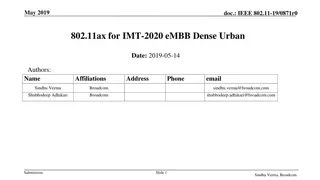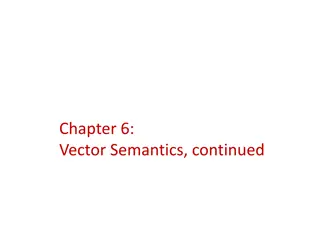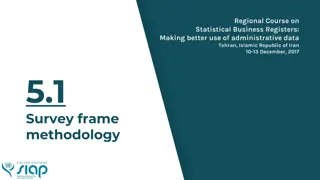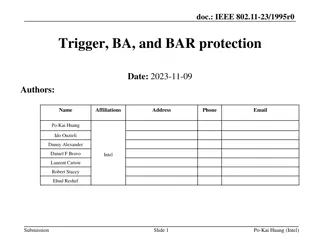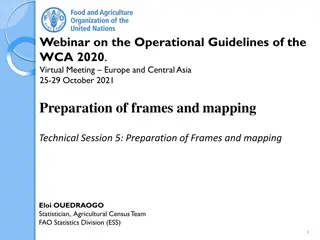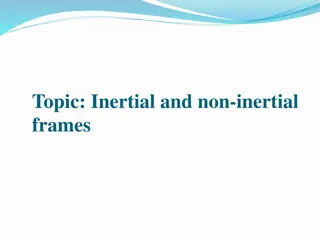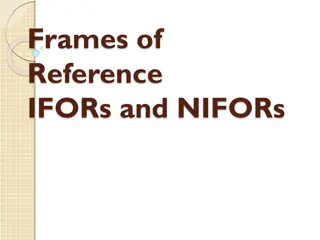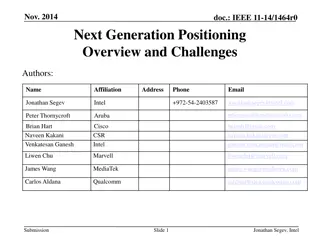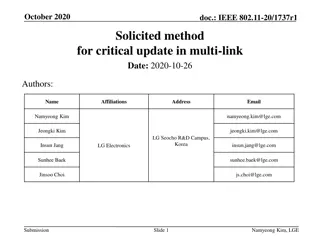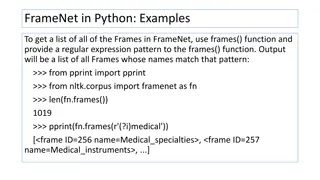Efficient Positioning Method with Beacon Frames in Dense Multi-User Scenarios
Proposing a method for positioning in dense multi-user scenarios to reduce the number of transmissions needed. This method does not require AP synchronization and can support a large number of STAs. Initial measurement results are provided. Addressing localization challenges and overhead issues in such scenarios.
Uploaded on Mar 21, 2025 | 3 Views
Download Presentation

Please find below an Image/Link to download the presentation.
The content on the website is provided AS IS for your information and personal use only. It may not be sold, licensed, or shared on other websites without obtaining consent from the author.If you encounter any issues during the download, it is possible that the publisher has removed the file from their server.
You are allowed to download the files provided on this website for personal or commercial use, subject to the condition that they are used lawfully. All files are the property of their respective owners.
The content on the website is provided AS IS for your information and personal use only. It may not be sold, licensed, or shared on other websites without obtaining consent from the author.
E N D
Presentation Transcript
July 2017 Efficient Positioning Method using Beacon Frames Date: 2017-07-12 Authors: doc.: IEEE 802.11-17/0981r0 Name Vladica Sark Affiliations Address IHP Phone email sark@ihp- microelectronics.com Im Technologiepark 25, D-15236 Frankfurt (Oder), Germany dito grass@ihp- microelecttronics.com teran@ihp- microelectronics.com Eckhard Grass IHP Jesus Gutierrez Teran Nebojsa Maletic IHP dito maletic@ihp- microelectronics.com IHP dito Submission Slide 1 Vladica Sark, IHP
July 2017 doc.: IEEE 802.11-17/0981r0 Abstract We propose a method for positioning, which can be used in dense multiuser scenarios. The main objective is to reduce the number of transmissions needed. The proposed method does not require synchronization of the APs and can support a virtually unlimited number of STAs. Some initial measurements results are provided. Submission Slide 2 Vladica Sark, IHP
July 2017 doc.: IEEE 802.11-17/0981r0 Localization in Dense Multi User Scenarios The Fine Timing Measurement (FTM) protocol generates additional traffic overhead and is hardly applicable in scenarios with a large number of users According to [1], 384 s is the minimum time per single FTM exchange With 1000 users and 0.5 Hz update rate (one update per 2 seconds) the medium is consumed for 19% of the time. [1] With N co-channel APs, the overhead gets N-fold worse [1] Averaging is usually used for improving the measurement precision. This additionally increases the overhead Submission Slide 3 Vladica Sark, IHP
July 2017 doc.: IEEE 802.11-17/0981r0 Solution [IEEE 802.11-16/1249r0] sequential beacons The proposed solution has similarities with GPS Except: Sequential transmission with virtual synchronization of APs AP1 transmits a timing frame (TF) frame to AP2, AP2 to AP3 and so on Replies from AP2 to AP1, AP3 to AP2 and so on, can be very short ACKs STAs also receive the TFs form the APs AP1 AP2 AP3 AP4 TF TF ACK TF ACK TF ACK STA Submission Slide 4 Vladica Sark, IHP
July 2017 doc.: IEEE 802.11-17/0981r0 Testing scenario Transceiver Channel BW (3dB): 25 MHz, roll-off 1.00 Sample rate: 50 MSps Ranging sequence: m-sequence, 1023 chips, BPSK, 2x oversampling Submission Slide 5 Vladica Sark, IHP
July 2017 doc.: IEEE 802.11-17/0981r0 Obtained results mobile scenario Processing In software 4-5 measurements per second Position filtering Moving average 5 last estimates Maximum velocity limit Accuracy: 1-2 meter Submission Slide 6 Vladica Sark, IHP
July 2017 doc.: IEEE 802.11-17/0981r0 Precision in a static case Variation of the performed measurements with respect of the mean value CDF of the estimated distance difference (not a CDF of position estimate) Submission Slide 7 Vladica Sark, IHP
July 2017 doc.: IEEE 802.11-17/0981r0 Proposed modifications with respect to [IEEE 802.11-16/1249r0] APs Transmit beacon frames (BF) (not sequentially) Receive beacon frames and estimate ToA Include estimated ToA in the transmitted beacon frames STA Receives beacon frames and estimates ToA Use the ToAs in the beacon frames to estimate position AP1 BF AP2 AP3 AP4 BF BF BF STA Submission Slide 8 Vladica Sark, IHP
July 2017 doc.: IEEE 802.11-17/0981r0 Proposed modifications (2) APs Need to be able to listen to the other APs Must estimate ToA of the arriving beacon frames and report to the STAs (e.g. including them in beacon frames) STA Must be able to listen to all of the APs at best simultaneously Pros: Passive, i.e. number of STAs not limited Low number of transmissions for positioning purposes Cons: Additional complexity to listen to all APs Time between transmission of beacon frames from different nodes must not be too big Submission Slide 9 Vladica Sark, IHP
July 2017 doc.: IEEE 802.11-17/0981r0 Conclusion The proposed approach further reduces the number of transmissions needed to perform localization of mobile stations APs must not be synchronized, but must be able to listen to the neighboring APs The larger the number of involved APs, the better the precision - scalable system. Submission Slide 10 Vladica Sark, IHP
July 2017 doc.: IEEE 802.11-17/0981r0 References [1] Brian Hart et al., Scalable Location, IEEE 802.11- 14/1235r0 Submission Slide 11 Vladica Sark, IHP
July 2017 doc.: IEEE 802.11-17/0981r0 Straw pool Should the APs and STAs support listening on multiple channels simultaneously in order to enable passive positioning of STAs? Yes: No: Abstain: Submission Slide 12 Vladica Sark, IHP
